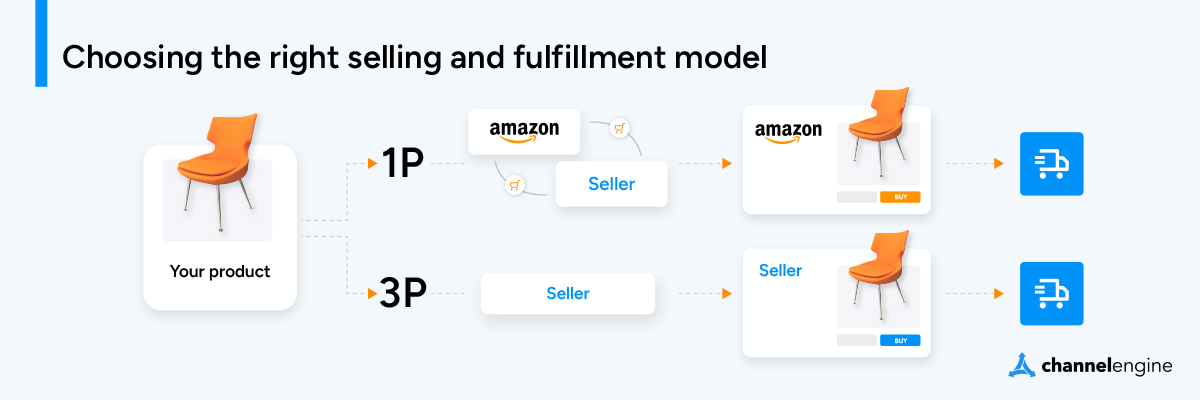In today's ecommerce landscape, having a well-defined marketplace strategy is critical for every brand's success. Marketplaces account for 62% of all online purchases, and omnichannel retailers generate 190% more revenue.
Let’s take a look at how brands can set themselves up for success in this critically important area of ecommerce.
Why a strong marketplace strategy matters
As marketplaces have grown in size and popularity, so too has the competition. They are a battleground for ecommerce brands and agencies to compete for visibility, high positions in search results, and a place in the Buy Box.
Brand equity accumulated by years of traditional advertising and in-store sales will only help to a limited degree.
On marketplaces, your listings must be optimized and your fulfillment should match consumer expectations. You also need to deliver excellent customer service and a steady stream of positive ratings and reviews, or your products will not be visible and you won’t make sales. Achieving all of this is a challenge! But that’s why a comprehensive marketplace strategy is so critical. Let’s explore everything you need to consider to build a strategy that delivers results.
Choosing the right selling and fulfillment model: A strategic approach to marketplace success

The choice between a first-party (1P) and third-party (3P) sales model is crucial when developing a marketplace strategy because it can directly impact the strategic direction of your company.
In a 1P, or first-party, arrangement, the marketplace, such as Amazon, buys your product wholesale and handles most of the selling details.
On the other hand, in a 3P relationship, you are an independent seller on Amazon's marketplace. This provides you greater control over your brand, but more responsibility for setting the price and managing the listings.
There is no right or wrong approach, as each model has its advantages and disadvantages to be considered in line with your business goals.
The first-party sales model
Advantages
- Operations are streamlined in a 1P model because the marketplace handles order fulfillment, customer support, and other operational duties. Your company will have more time and resources to devote to key projects and core operations.
- Speed to market: Since the marketplace handles a large portion of the backend logistics, selling in a 1P model enables quicker market entry, making it a desirable choice for companies seeking quick market penetration.
- Leveraging marketplace reach: Joining forces with reputable marketplaces gives you direct access to a large consumer base, exposing your goods to a wider market and increasing brand recognition.
Disadvantages
- Loss of control: Giving up some control over price, customer service, and inventory management entails entrusting the market with operational chores. Outsourcing can lead to suboptimal outcomes. If you need to shift some old stock, you have less agility to drop the price.
- Limited branding possibilities: Since the marketplace brand tends to be the focus (Amazon, for example), selling as a 1P leads to fewer branding possibilities on the platform.
The third-party sales model
Advantages
- A 3P model gives you more control over branding, pricing, and customer interactions. This enables you to create a brand identity that is more distinctive and to precisely personalize the consumer experience to match your vision.
- Personalized relationships: You may develop stronger ties with your target market and encourage brand loyalty and repeat business by having direct access to consumer data and interactions.
- Flexibility in Pricing: A 3P model gives you the freedom to determine your pricing strategy on your own, allowing you to try out different price strategies and react more swiftly to market changes.
Disadvantages
- Operational Responsibilities: As you are in charge of most of the ecommerce operations, the 3P model calls for more active management. Additional resources and knowledge could be needed for this.
- Competition in the market: As a third-party seller, you must outsell others that are offering comparable products, which could result in price wars and margin pressure.
- Market ranking obstacles: The rivalry might make it tough to stand out without a significant expenditure, and gaining more awareness in the market may need creative marketing efforts.
Your overall business strategy and objectives should be in line with your decision between the 1P and 3P sales models. You can enhance your marketplace strategy and set up your company for success in the dynamic ecommerce landscape by carefully weighing the advantages and disadvantages of each model. By doing this, you can reach an informed conclusion that uses the advantages of your chosen approach.
Winning the Buy Box
Winning the Buy Box position on Amazon, Walmart or Bol.com is a highly sought-after achievement. When a buyer clicks "Add to Cart" or "Buy Now," the sale is attributed to your listing because you were chosen as the seller in the Buy Box.
It is impossible to stress how important this position will be to your sales since more than 80% of Amazon purchases take place through the Buy Box. The difficult balancing act between offering competitive pricing and protecting profit margins must be carefully navigated by sellers to achieve Buy Box supremacy.
Pricing strategy is a primary factor when pursuing the Buy Box. Marketplaces often favor lower-priced products to meet consumer demands, so maintaining a competitive price can improve your chances of landing in the Buy Box. However using this strategy might mean giving up profit margins.
Sellers who place a high priority on preserving healthy profit margins run the danger of missing out on the Buy Box to rivals who offer more aggressive pricing. Finding the right balance is essential to your marketplace strategy since it defines your eligibility for the Buy Box while preserving your profitability. Repricing software is highly effective in enabling brands to sell at the optimal price, as often as possible.
The Buy Box algorithm takes into account more than just price. A key factor in eligibility for the Buy Box is inventory availability and the ability to offer quick and dependable shipment. Opting for a third-party fulfillment model on Amazon supports this as it guarantees on-time delivery and inventory availability.
Sellers are more likely to hold this highly desirable position in the eyes of marketplaces if they display good performance indicators, such as prompt customer query responses and low order defect rates.
Getting your pricing right!
Pricing is a central component of your marketplace strategy. Establishing ideal price points that appeal to consumers and help you win the buy box while preserving a healthy profit margin requires a good understanding of the pricing strategies used by other companies in your sector.
Amazon has almost 2 million sellers, but rather than finding that daunting, see it as an opportunity to learn from those performing well.
There are several pricing strategies you can implement within the ecommerce marketplace, depending on the products you offer and your business goals.
1. Value-Based Pricing: To justify premium pricing, emphasize the unique value proposition of your items, emphasizing quality, exclusivity, or additional features that distinguish your offerings.
2. Dynamic Pricing: To maximize revenue and remain competitive, use a dynamic pricing method that adjusts to market swings, demand patterns, and seasonal trends.
3. Promotional Pricing: Create a sense of urgency and increase customer conversions by strategically offering time-limited discounts, bundle offers, or loyalty recognition.
4. Tiered Pricing: To appeal to a broader spectrum of customers and optimize revenue potential, offer tiered pricing based on product varieties, quantities, or customer categories.
5. Price bundling: Combine complementary items or services at a lower cost to encourage upsells and boost average order value.
6. Introduce subscription-based pricing structures to increase loyalty, generate recurring revenue, and strengthen long-term customer connections.
Your initial pricing strategy should never be fixed. Experiment with A/B testing to understand what works best for your business demographic.
The importance of reviews
Customer feedback has a significant impact on your marketplace success. Approximately 91% of 18-34-year-olds trust online reviews as much as personal recommendations.
Positive feedback can be a valuable asset in your marketplace strategy. To establish credibility and trust with potential customers, prominently promote positive reviews on your product listings and website. Use these testimonials as social proof to show the value and satisfaction that prior customers expressed.
Ensure you seek out reviews from happy buyers by sending follow-up emails or offering incentives. This will help to build up your brand's reputation and draw in new customers.
To demonstrate your dedication to providing exceptional customer service, reply to all reviews as soon as possible and with grace, addressing any concerns or issues that may have been brought up.
By using positive feedback in your marketplace strategy, you establish a loop of trust and loyalty, gaining the confidence of future customers and increasing conversion rates.
Providing excellent customer service
A critical pillar for your online reputation and long-term success in the ecommerce business is exceptional customer service. Responding to customer queries quickly and accurately, as well as resolving refunds and exchanges promptly, are critical components of this strategic approach. Positive customer experiences lead to excellent reviews and a devoted consumer base.
Prioritizing consumer satisfaction in your marketplace strategy is essential for building a brand reputation that encourages repeat purchases and solidifies your market position. Research shows that 20% of repeat customers are responsible for 80% of future income.
By providing outstanding service, you not only gain trust and loyalty, but also increase your market visibility through positive feedback and word-of-mouth referrals. Anticipate consumer demands and handle potential difficulties or complaints as part of your strategic customer service approach to provide a seamless shopping experience.
Invest in educating your customer service employees so that they can answer queries and address problems with empathy and efficiency. A customer-centric approach that prioritizes surpassing expectations is a strategic advantage that can distinguish your business from competitors.
Furthermore, use consumer input to constantly enhance your customer service operations. Customer feedback and interactions can provide valuable insights into areas for improvement, helping you to fine-tune your marketplace approach and provide unparalleled consumer experiences.
Product listing optimization
Optimizing your product listings is critical for attracting new buyers and improving search rankings.
- Conduct extensive keyword research to uncover relevant and high-impact keywords for your product listings, with the goal of increasing their exposure in marketplace search results.
- To engage potential buyers, create compelling and informative product titles and descriptions that highlight unique features, benefits, and selling points.
- Use high-quality, visually appealing photographs to present your products from various angles, attracting shoppers' attention and raising click-through rates. 75% of online shoppers will look at product pictures first.
- In order to develop trust and credibility with potential buyers, incorporate social proof features such as consumer reviews and ratings.
- Regularly monitor marketplace metrics and customer comments to constantly update and optimize your product listings for maximum performance and customer appeal.
Review and optimize your listings frequently based on feedback and marketplace information.
Ensuring a smooth fulfillment process
Strategic fulfillment is a critical component of your marketplace strategy that has a direct impact on customer satisfaction, brand reputation, and long-term success. Brands can employ a variety of initiatives, like the ones listed below, to ensure a seamless and efficient fulfillment process.
- Implement reliable inventory management solutions that provide real-time tracking and precise stock level updates. Brands can prevent overselling, stockouts, and late order fulfillment by keeping accurate inventory data.
- Implement simplified order processing technologies that automate order fulfillment, reducing manual errors and delays. Integrating your marketplace with your internal order management system can improve efficiency and cut fulfillment time.
- Shipping and delivery can be improved through strategic collaborations with reputable shipping companies and fulfillment facilities. Provide a variety of shipping alternatives to meet the needs of different customers, including expedited shipment for time-sensitive purchases.
- Embrace emerging ecommerce technologies to automate repetitive operations such as order confirmation emails, shipping tracking notifications, and return processing. Automation improves operational efficiency and frees up time for firms to focus on their marketplace strategy.
- Thoughtful packaging and branding can offer a great unboxing experience, making a lasting impression and strengthening brand identification. Customer satisfaction and brand loyalty improve by personalizing packaging.
It is critical to maintain open and proactive communication with customers throughout the fulfillment phase. Providing order status updates, tracking information, and prompt responses to inquiries helps your brand create trust and confidence.
Final words
A well-executed marketplace strategy can transform ecommerce brands. You can position your brand for success by selecting the right selling and fulfillment models, winning the Buy Box, optimizing pricing and reviews, providing exceptional customer service, and optimizing product listings and fulfillment processes.
Keep in mind that ongoing evaluation, adaptation, and development are essential for remaining competitive and succeeding in the ever-changing world of online marketplaces.
Speak to a team of experts and get your custom demo today.





